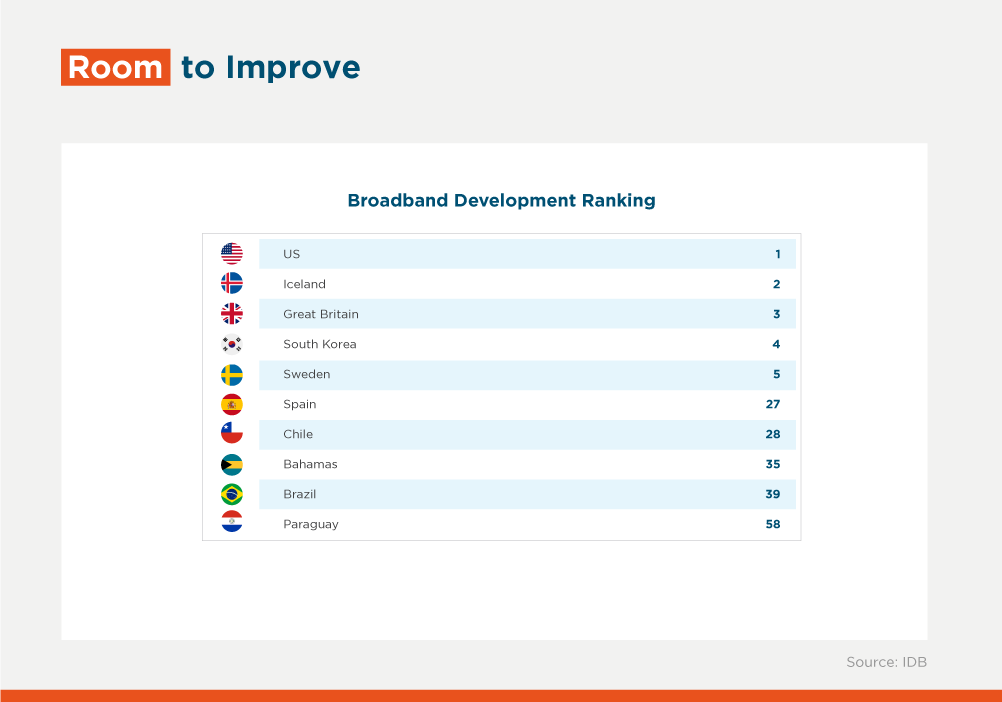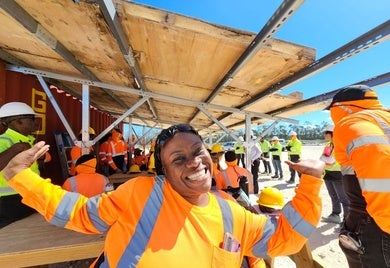Digital Connectivity: Oil for the 21st Century

Digital connectivity is something that seems obvious and invisible, but it is not. High-capacity data-carrying connections are going to be, if they aren't already, the oil of the 21st century: a potential source of great wealth for the countries that best exploit this resource.
A great example of this potential is Paraguay. With its strategic location equidistant from the large economies of South America, it’s already home to the Paraguay-Paraná Waterway that connects Brazil with Uruguay as an oceanic exit route and also road routes under the construction – the Bioceanic Corridor, which will connect the ports of Brazil with those of Chile, passing through the Paraguayan Chaco, thanks to public-private alliances.
Paraguay, in terms of digitization and connectivity, is still far from developed countries, as evidenced by its position 58 out of 65 countries in the IDB Broadband Development Index 2018; it doesn’t rank high in the sub-indices either and, if we consider only Latin American and Caribbean (LAC) countries, Paraguay's position is 19 out of 26.

Among the country's main constraints regarding the cost of connectivity, international output is a bottleneck. This is due to the few escape points available (Brazil and Argentina), which makes IP transit prices in Paraguay are much higher than the average, with a value between US$10-20/Mbps, compared to the average price paid in Brazil of US$3-6/Mbps or Europe, where transit costs no more than US$1/Mbps. This extra cost is transferred to the retail price and also limits the ability of small operators to compete or the entry of new competitors and investors into the market.
In 2018 a project known as “Banda Ancha Paraguay” was launched, initially promoted by the IDB with financing from Itaipú Binacional. The project has looked for alternatives that allow to obtain a Paraguayan fiber optic connection with access to the ocean, which would allow national companies to acquire access at a more competitive cost.
After a feasibility study carried out by Deloitte Spain, it was concluded that the best alternative was the use of the electricity transmission lines shared by Paraguay and Brazil through Itaipu to Sao Paulo.
This connectivity proposal is still limited since the information transfer capacity that this connection would be only 200 Gbps, compared to the capacity that an independent fiber optic network could have, according to the original project, being able to reach at least at 16 Tbps – assuming 40 channels (lambdas) of 100 Gbps each in a pair of optical fibers and four pairs in a 12-fiber cable – which would be 80 times faster.
Now, the question is whether Paraguay needs a fiber optic network. To answer the question, we must visualize the global changes that are taking place rapidly in terms of digitization: there are estimates that 5G technology will have a global impact of US$13.2 trillion by 2035, affecting productivity in all industries, including agriculture, manufacturing, services, governments and others. Taking advantage of these new advances would only be possible if the country has the appropriate digital infrastructure.
A Paraguayan fiber optic network would represent a strategic opportunity to achieve the installation of a large regional data center in the country, serving as a connection route for exits to the Atlantic from Uruguay, by its own route, and to the Pacific, passing through Argentina and Chile. This outlet to both oceans would be the only one in South America and would be of strategic interest not only for the region, but even for Europe and Asia as an alternative connection, since currently its main connections are through conflict zones in the Middle East.
Paraguay has a bi-oceanic outlet, as do Bolivia or Peru, which could be other major stakeholders; however, Paraguay has other factors that differentiate it, especially abundant and cheap electricity, and a location with low risk of natural disasters.
The main challenge for the public sector is the decrease in the cost of international connectivity through its own fiber optic network. An investment of this type could only be made by the government or through a public-private partnership, since it also has a high social component due to the potential benefit for the population.
A data center in the country would generate great interest for the sector or private, being especially attractive for companies that offer "cloud" services (data storage on the Internet) both public (Apple, Amazon, Google, Microsoft, Samsung, Alibaba and Tencent, for example) and private (industry, financial sector, services in general) and even telecommunications and government. This digital infrastructure and its continental reach could even justify investment in new submarine cables for alternative outlets to Asia and Europe.
The range of investments that a data center can attract is almost incalculable, in addition to the advantages in terms of improving the coverage and prices of connectivity in the country and the region, so it will have a transversal effect on the entire economy and the society in general. In LAC, on average, a 10% higher broadband penetration is associated with a 3.19% higher GDP, 2.61% higher productivity, and 67,000 new jobs.
We must resume conversations around the original idea of the "Broadband Paraguay" project, since the proposal to use the Itaipu transmission network will only allow to cover in the short term the demand for connectivity in the country, in addition to limiting any investment that requires a high flow of information. The opportunity cost of not acting now can be incalculable.
LIKE WHAT YOU JUST READ?
Subscribe to our mailing list to stay informed on the latest IDB Invest news, blog posts, upcoming events, and to learn more about specific areas of interest.
Subscribe



